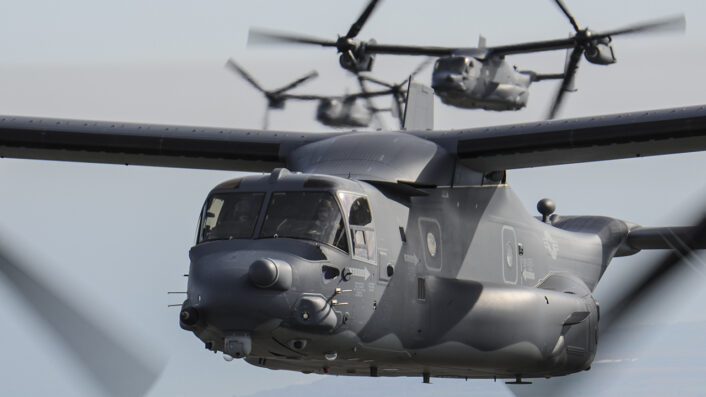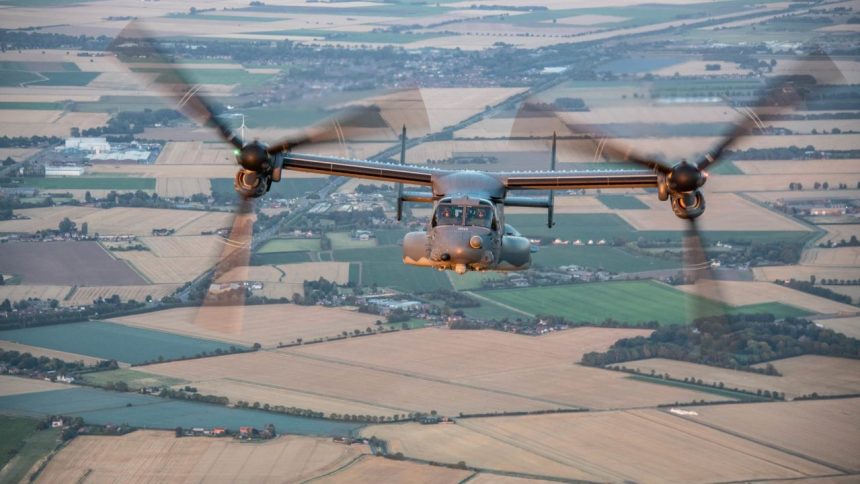The U.S. Air Force’s Accident Investigation Report says that the CV-22 crash could have been prevented had the crew decided to land earlier and at a closer airfield.
The Nov. 29, 2023 crash of the CV-22B of the U.S. Air Force Special Operations Command off the coast of Yakushima in Japan, that killed eight American personnel, was owing to “catastrophic failure” in one of the aircraft’s PRGBs (Prop Rotor Gearboxes), the Aircraft Accident Investigation Board has found. Previous reports, including here at The Aviationist, had noted that, while a recurring “hard clutch engagement” had been a cause behind previous accidents, investigators had determined a different “parts failure” for this time around.
A few months ago, some officials identified off the records the gearbox as the culprit part (the ‘what’), and were examining “why” and how it failed. This aspect currently remains unclear, but more light has been shed on the manner in which the gearbox failed and what transpired in the cockpit.
From Dec. 6, 2023, through May 30, 2024, the AAIB conducted interviews, perused maintenance logs, flight recorder data, briefing materials, and inspection of aircraft wreckage. The ill-fated Osprey, assigned to the 21st Special Operations Squadron, 353rd Special Operations Wing at Yokota Air Base, was participating in a joint interoperability exercise when the mishap happened.
an MV-22B Osprey from Marine Medium Tiltrotor Squadron (VMM) 262 takes off from the USS America while conducting routine operations in the Philippine Sea, July 24, 2024. ( j andre) pic.twitter.com/DAv4BisYmE
— J.J. (@kadonkey) August 5, 2024
The accident, the fourth in two years, led to a worldwide safety stand down of about 400 Osprey tilt-rotor aircraft. The U.S. military operates three different Osprey versions: the U.S. Marine Corps flies the MV-22B; the U.S. Navy flies the CMV-22 Carrier Onboard Delivery variant and the U.S. Air Force operates the CV-22B. The JGSDF (Japan Ground Self-Defense Force) operates a total of 14 Ospreys, with three more to be delivered to complete an order of 17 aircraft.
The Japan MoD and the US in March then announced a “gradual” and “phased” resumption of Osprey flights, with new training on maintenance and piloting procedures for crews and pilots.
The PRGB failure
The CV-22 is a unique tilt-rotor aircraft, equipped with a prop-rotor gearbox in each engine nacelle which allows to transmit the power from the engine to the proprotor and reduce the speed of the shaft. The catastrophic failure which caused the crash was located in the Osprey’s left-hand PRGB. Here is an excerpt from the AIB report:
“Failure of the left-hand PRGB high-speed planetary section was most likely initiated by a crack in one of the high-speed pinion gear and fatigue cracking of the associated pinion gear’s bearing cage, which eventually fractured through the high-speed planetary carrier assembly. At least one piece of the failed high-speed planetary pinion wedged in the high-speed carrier assembly, grinding against the high-speed sun gear’s teeth until they were completely removed. The removal of the gear teeth prevented torque being applied to the left-hand mast”.
The report then mentions that an onset of rapidly cascading malfunctions occurred less than six seconds after the failure. This resulted in an instantaneous asymmetric lift condition that the investigation determined was unrecoverable by the mishap crew.
“That resulted in a complete roll. The aircraft did two full rolls and ended up impacting the water,” AFSOC chief Lt. Gen. Michael E. Conley, an Osprey pilot and the head of the Accident Investigation Board, told the media.

The accident
After about 40 minutes of taking off from Marine Corps Air Station Iwakuni during the “fairly routine” exercise, the crew received two “PRGB CHIP BURN” alerts in less than a minute. The advisory appears on the CDU screen in the cockpit without an auditory warning. The crew acknowledged the alert and went ahead with the training mission while reviewing the checklists, as the landing criteria were not met.
Twelve minutes after the second one, the third advisory appeared in the cockpit. The crew then acknowledged they were in the “land as soon as practical” criteria required after three chip burns, however the pilot elected to still continue the mission. The advisory appeared again two times after that.
About 70 minutes into the flight and 300 nautical miles over the sea headed to Kadena, the crew received a “L PRGB CHIPS,” which means the chip detectors found pieces of metal that can’t be burned off. This notification finally prompted the commander to verify the aircraft was dealing with a “land as soon a possible” condition.
The pilot passed the controls to the copilot, directing to turn to Yakushima Island, the nearest planned divert airfield about 96 km away, despite other closer options for landing. During contact with the ground operator, the crew identified the Osprey as an emergency aircraft but did not ask for priority landing.
During a holding pattern while waiting for traffic to clear the runway, the crew also received a “CHIP DETECTOR FAIL” advisory, meaning one of the chip detectors stopped working. A few minutes later, while the aircraft was two minutes from landing, the pinion gear completely failed, with the subsequent cascade of malfunctions which caused the left proprotor to stop spinning. The Osprey went into a roll and violently crashed into the water.
En la punta de cada pala de los Osprey se encuentra una pequeña luz led verde. Su función es iluminarse de noche para poder ver donde se encuentran las puntas de los rotores evitando así accidentes con los operadores de tierra o entre aeronaves que se encuentren en vuelo. pic.twitter.com/0DCoFRgpNZ
— On The Wings of Aviation (@OnAviation) August 6, 2024
‘Crew ignored snag warnings’
Conley added that the accident could have been prevented had the crew decided to land earlier and at a closer airfield. Interestingly, one of the restrictions announced on the Osprey earlier this year is to not fly for more than 30 minutes away and only around a suitable airfield where the crew can quickly return in case something goes wrong.
“I can’t prove that with 100% certainty, but the investigation indicates that time mattered in this, that the failure progressed over time,” added the General. “If an earlier decision to land had been made, I do believe that there was an alternative ending.”
“By the preponderance of evidence, Mishap Pilot’s (MP) decisions were causal, as they prolonged the mishap sequence and removed any consideration of an earlier landing at a different divert location,” the report added. The report lso identified “inadequate risk management” and “ineffective crew resource management” contributing to an “insufficient sense of urgency.”

‘Sometimes mission pressure takes precedence’
At the same time, Conley acknowledged the “internal pressure” on the crew for continuing the mission after weeks and months of planning. Therefore, while new Air Force advisories now recommend crews to land following “chip burn” alerts, Conley also said pilots do retain some discretion.
“We need our aircraft commanders to be trusted up there,” he said. “We can’t get in the cockpit with them from afar so we have to trust them to do what they think is in the best interest of the crew.”
Lastly, investigators also blamed the V-22 JPO (Joint Program Office) for “inadequately communicating to the military services” data on the strength and reliability of the left-hand PRGB’s (Proprotor Gearbox) internal components that “substantially contributed to the mishap,” according to the summary.









